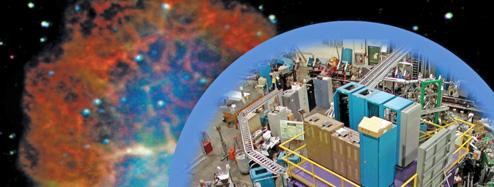
The global, perhaps even stellar, significance of TRIUMF’s nuclear astrophysics program was featured on MSNBC.com’s Cosmic Log on January 4, 2008, in an article by renowned science journalist Alan Boyle.
Mr. Boyle took a tour of TRIUMF in November 2007 and saw first-hand the research being conducted here, as well as some of the facilities and instruments invented for it. In his article, “Inside the Supernova Machine,” Boyle writes,
“In this age of bigger, newer, more powerful mega-machines for particle physics, Canada's 33-year-old TRIUMF cyclotron is literally a blast from the past. Sure, it's the world's biggest cyclotron -- but to some physicists that might sound a bit like gushing over the world's most advanced horse and buggy. In terms of size and sheer power, TRIUMF's 59-foot-wide magnet is dwarfed by Europe's 5.3-mile-wide Large Hadron Collider. When it gets up and running this year, that super-duper-collider will pack a punch 28,000 times greater than TRIUMF's. Nevertheless, there are some things being done at the TRIUMF lab, next to the University of British Columbia's Pacific coast campus, that the bigger places just won't do -- such as figuring out how one element turns into another inside an exploding star.”
To read the entire article, see MSNBC.com’s Cosmic Log.
About the author: Alan Boyle covers the physical sciences, anthropology, technological innovation and space science and exploration for MSNBC.com. He is a winner of the AAAS Science Journalism Award, the NASW Science-in-Society Award and other honors, a contributor to A Field Guide for Science Writers; (Oxford University Press), and a member of the board of the Council for the Advancement of Science Writing.
